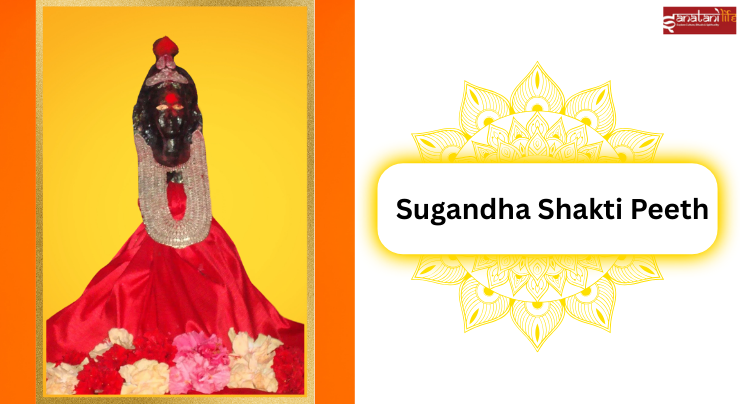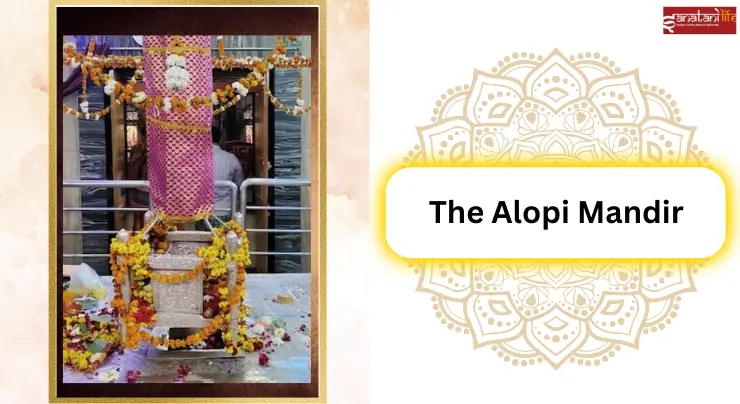Shri Vishalakshi Mata Shakti Peeth
Situated in the spiritually rich environment of Varanasi, where the sacred Ganges flows and ancient chants echo through temple corridors, lies the Shri Vishalakshi Mata Shakti Peeth, commonly referred to as the Vishalakshi Temple or The Vishalakshi Shakti Peeth. This venerated temple is a significant representation of divine feminine energy and ranks among the 51 sacred Shakti Peeths in India, believed to be sites where the body parts of Goddess Sati fell, imbuing the region with profound spiritual significance.
Thank you for reading this post, don't forget to subscribe!Shri Vishalakshi Mata Shakti Peeth is more than just a temple; it serves as an everlasting sanctuary devoted to the worship of Shakti. The term “Vishalakshi,” which translates to “the one with wide and compassionate eyes,” symbolizes a goddess who perceives all, nurtures all, and bestows her followers with protection, wisdom, and tranquillity. Located in the holy city of Kashi (Varanasi), this esteemed temple is part of a revered spiritual triad alongside the Annapurna Devi Temple and Kashi Vishwanath Temple, making it an essential destination for pilgrims in search of salvation, inner strength, and a connection to the divine.
Mythological Origins of Vishalakshi Shakti Peeth
The Legend of Sati and the Emergence of Shakti Peeths
The narrative of the Shakti Peeths is rooted in a tale of cosmic love intertwined with a tragic sacrifice. Goddess Sati, the daughter of King Daksha and the beloved consort of Lord Shiva, chose to self-immolate in a sacred fire following her humiliation at her father’s grand yajna. Overcome with grief and rage, Shiva traversed the cosmos with her charred remains, causing chaos in his profound sorrow.
To pacify Shiva and restore cosmic equilibrium, Lord Vishnu employed his Sudarshan Chakra to sever Sati’s body. Each fragment that descended to Earth transformed into a Shakti Peeth, representing a potent centre of feminine divine energy. These revered locations have become significant pilgrimage sites, each imbued with the essence of Adi Shakti.
What Resided at Vishalakshi Peeth?
Ancient scriptures suggest that the earring (kundal) or the face of Goddess Sati fell at the location where the Shri Vishalakshi Mata Temple now stands in Varanasi. This occurrence sanctified the area, elevating it to one of the most sacred among the 51 Shakti Peeths. The name “Vishalakshi,” which translates to “wide-eyed,” symbolizes the goddess’s all-seeing and compassionate nature, perpetually watching over her devotees.
A Representation of Strength and Safeguarding
Within the divine trinity of Shakti—comprising Durga, Lakshmi, and Saraswati—Vishalakshi Mata occupies a position of both power and grace. Her status as a Shakti Peeth renders the temple a site of profound spiritual energy, where devotees seek empowerment, protection, and divine wisdom.
The Deity – Vishalakshi Mata
Who is Vishalakshi Mata?
Vishalakshi Mata, meaning “She of the Wide Eyes,” is a highly venerated manifestation of the Divine Mother. Her wide eyes symbolize her vigilant observation, allowing her to perceive the suffering, devotion, and aspirations of all her followers. In this aspect, she represents compassion, wisdom, and protection.
Although she is worshipped as an independent deity, many devotees regard her as a form of Parvati, the wife of Lord Shiva, and also as Annapurna, the goddess who sustains the universe. Her various manifestations link her to both fierce energy and nurturing grace.
Divine Feminine Energy in Its Purest Form
As a Shakti Peeth, the Vishalakshi Temple possesses profound spiritual importance. It is believed that the goddess bestows her devotees with strength, clarity, and success in both spiritual and worldly endeavours. Women, in particular, seek her blessings for marital happiness, fertility, and emotional resilience.
Many individuals also appeal to her for relief from suffering, mental tranquillity, and the removal of obstacles—attributes that render her a deeply personal and caring deity for numerous worshippers.
Vishalakshi’s Position Among the Shakti Peeths
Among the 51 Shakti Peeths, Vishalakshi Mata occupies a distinctive position due to her location in Kashi, the spiritual heart of India. Her energy is said to resonate with the powerful aura of Kashi Vishwanath and the nurturing grace of Annapurna Devi, establishing this Peeth as a complete embodiment of divine feminine strength.
How to Reach Vishalakshi Temple
Closest Railway Station to Vishalakshi Temple
The closest railway station to Vishalakshi Temple is Varanasi Junction (BSB), which is well-linked to key cities across India, including Delhi, Kolkata, Mumbai, and Lucknow. The temple is situated approximately 3.5 km from the station, making it easily accessible by auto-rickshaws, cycle rickshaws, or taxis. Another nearby station is Manduadih (MUV), located about 6 km from the temple. This station accommodates a significant number of trains and serves as a convenient option for travellers.
Nearest Airport and Air Travel Options
The nearest airport to Vishalakshi Temple is Lal Bahadur Shastri International Airport (VNS), situated roughly 25 km from the city centre. The airport offers regular flights from major Indian cities such as Delhi, Mumbai, Bengaluru, and Hyderabad, along with some international routes. Upon arrival at the airport, taxis and ride-hailing services like Ola and Uber are readily available to transport you directly to the temple or your accommodation in Varanasi.
Temple Architecture of Vishalakshi Shakti Peeth
Historical Context and Renovations
The Vishalakshi Temple is thought to have ancient roots, as evidenced by references in sacred scriptures and local folklore. Throughout the ages, the temple has experienced numerous renovations and restorations, particularly during the medieval era and with the support of South Indian devotees. A notable restoration was undertaken by a community of Tamil devotees, which played a crucial role in maintaining the temple’s sanctity and structure amidst the vibrant streets of Varanasi.
Even though it is situated within the dense and historic urban landscape, the temple has preserved its spiritual allure and simplicity, serving as a living connection between the past and the present.
Description of the Sanctum and Idol
At the core of the temple is the sanctum sanctorum (garbhagriha), where the divine idol of Goddess Vishalakshi is housed. The deity is adorned with luxurious silks, jewelry, and fresh flowers. She is portrayed with wide, compassionate eyes, symbolizing her all-seeing and nurturing nature.
The idol radiates a maternal presence, inviting devotees to engage in prayer, perform rituals, or simply sit in quiet meditation. The sanctum is intimate, traditional, and imbued with spiritual energy, allowing visitors to forge a close and personal connection with the goddess.
Distinctive Features of Vishalakshi Temple’s Architecture
In contrast to the grand temples typically found in South India or even the nearby Kashi Vishwanath, the Vishalakshi Temple is modest in size yet profoundly impactful. It showcases influences of Dravidian architecture, particularly in the gopuram (tower) structures and interior design, due to the contributions of Tamil devotees during its restoration.
The temple is characterized by vividly painted walls, intricate stone carvings, and detailed iconography representing various forms of Shakti. The inner courtyard and entrance are often embellished with rangoli designs and lamps, especially during festive occasions. These features create a warm and celebratory ambiance, despite the temple’s unassuming dimensions.
Comparison with Other Temples in Varanasi
Varanasi boasts a multitude of renowned temples, yet the Vishalakshi Shakti Peeth occupies a distinctive position. In contrast to the bustling magnificence of Kashi Vishwanath and the intricate beauty of Annapurna Devi Temple, Vishalakshi is distinguished by its tranquil atmosphere, emphasis on the divine feminine, and rich historical significance.
Moreover, it is among the select temples in Varanasi that is directly associated with the Shakti Peeth tradition, making it an essential destination for devotees engaged in Devi worship. The temple holds particular importance for women and spiritual aspirants who seek blessings for strength, compassion, and inner peace.
Festivals and Celebrations at Vishalakshi Temple
Navratri – The Most Majestic Festival
The Vishalakshi Temple experiences its most vibrant and spiritually uplifting moments during Navratri, which is celebrated biannually in Chaitra (March–April) and Ashwin (September–October). Over the course of these nine sacred nights, the temple transforms into a center of devotional fervor. Devotees gather in large numbers to offer prayers, recite mantras, and observe the traditional aarti, performed with immense passion.
Each day of Navratri is dedicated to a distinct manifestation of the goddess, featuring special pujas, homas (fire rituals), and cultural performances. The idol of Maa Vishalakshi is dressed in intricate garments, and the temple is adorned with beautiful lights and flowers.
Vishalakshi Jayanti
Another important event celebrated at the temple is Vishalakshi Jayanti, which is believed to commemorate the goddess’s appearance or her spiritual significance. Although this occasion is not widely recognized throughout India, it holds profound local significance. On this day, special abhishekam (ritual bathing), alankaram (decorations), and community feasts (annadanam) are organized.
Other Significant Rituals
Throughout the year, the temple conducts special pujas during full moon (Purnima) and new moon (Amavasya) nights, which are regarded as particularly auspicious for Shakti worship. Women devotees frequently engage in kumari puja, seeking blessings for marital harmony, fertility, and spiritual empowerment.
The festivals at Vishalakshi Temple are distinguished by the blending of North and South Indian traditions. Tamil devotees often carry out rituals and bhajans in their traditional manner, while the local community enthusiastically participates in prayers conducted in Hindi and Sanskrit. This cultural amalgamation enhances the inclusive and universal essence of the temple, ensuring that every celebration is both personal and grand.
Vishalakshi Temple and Its Connection to Kashi
An Ancient Center of Shakti in the City of Shiva
The Vishalakshi Temple occupies a distinctive position as a Shakti Peeth and is recognized as one of the oldest and most spiritually significant shrines in Kashi (Varanasi), the eternal city dedicated to Lord Shiva. This sacred city is regarded as the spiritual nucleus of India, and the presence of Vishalakshi Devi here signifies the profound union of Shiva and Shakti.
While Kashi Vishwanath serves as the principal deity of the city, Vishalakshi Mata is honored as the protective goddess, harmonizing the cosmic energies of Shiva with her nurturing and safeguarding essence. Devotees frequently visit both temples in succession, believing that their pilgrimage remains incomplete without receiving blessings from both the divine masculine and feminine.
A Symbol of the Divine Feminine in Kashi
In Kashi, where spiritual seekers aspire for moksha (liberation), Vishalakshi embodies the divine mother who compassionately guides souls and facilitates spiritual awakening. Her name, meaning “wide-eyed one,” symbolizes her omnipresent watchfulness over the residents and pilgrims of Kashi.
Vishalakshi is often worshipped alongside Annapurna Devi, another potent manifestation of Shakti residing in Kashi. While Annapurna nourishes the physical body, Vishalakshi is believed to nurture the soul, making her temple a vital stop for anyone on a spiritual quest.
A Temple of Devotion and Continuous Worship
In contrast to many Shakti Peeths that are visited primarily during specific seasons or festivals, the Vishalakshi Temple in Kashi is characterized by daily rituals, regular aartis, and a continuous flow of devotion. Locals and pilgrims gather here for personal prayers, special pujas, and offerings, ensuring that the temple’s atmosphere remains vibrant and spiritually charged throughout the year.
The Vishalakshi Temple transcends being merely a destination; it represents a living embodiment of the spiritual heritage of the ancient city and the enduring grace of the Divine Mother.
Nearby Attractions Around Shri Vishalakshi Mata Shakti Peeth
Kashi Vishwanath Temple – The Essence of Varanasi
Located just a short distance from the Vishalakshi Temple, the Kashi Vishwanath Temple stands as one of the twelve Jyotirlingas dedicated to Lord Shiva and is the most esteemed shrine in Varanasi. Devotees believe that visiting both Vishalakshi Mata and Kashi Vishwanath together fulfills the sacred cycle of Shiva-Shakti worship. The atmosphere within this temple is profoundly charged, and the experience of the aarti is both breathtaking and spiritually uplifting.
Annapurna Devi Temple – The Goddess of Nourishment
Next to Kashi Vishwanath, the Annapurna Devi Temple honours the goddess revered as the sustainer of life. According to tradition, Lord Shiva himself received alms from Annapurna at this site. Pilgrims frequently visit Annapurna Devi after their prayers at Vishalakshi, seeking both spiritual nourishment and material prosperity.
Dashashwamedh Ghat and the Enchanting Ganga Aarti
A visit to Varanasi would be incomplete without witnessing the Ganga Aarti at Dashashwamedh Ghat, located a short walk from the Vishalakshi Temple. This evening ritual, held at sunset, showcases a breathtaking array of lights, chants, and devotion along the banks of the holy Ganges. It represents a moment of harmony, where spirituality intertwines with tradition in a visually captivating manner.
Other Sacred Sites in Varanasi
The city of Varanasi is rich with spiritual sites, each radiating its own distinct energy. Explore Manikarnika Ghat, regarded as the portal to liberation, or visit Tulsi Manas Mandir, the birthplace of the Ramcharitmanas. Other notable pilgrimage destinations include the Durga Temple (Monkey Temple), Bharat Mata Mandir, and Sankat Mochan Hanuman Temple, all of which are well worth a visit.
A Sacred Connection to the Divine Feminine in Kashi
The Vishalakshi Shakti Peeth transcends the definition of a mere temple; it serves as an eternal wellspring of spiritual vitality, maternal kindness, and divine essence. Located in the revered city of Varanasi, this Shakti Peeth encourages devotees to engage with the everlasting energy of Goddess Vishalakshi, whose all-encompassing gaze is believed to safeguard and embrace all. A pilgrimage to this site is not solely a religious endeavour but also a profoundly personal and transformative journey.
Whether you are in search of blessings, tranquillity, or a deeper insight into the union of Shiva and Shakti, the Vishalakshi Temple occupies a significant position in India’s spiritual legacy. It is one of the parts of the 51 Shakti Peeths throughout India—a sacred network of centres dedicated to divine feminine power that you can explore to enhance your spiritual journey.
FAQ’s
Q- Where is the Vishalakshi Shakti Peeth situated?
Ans- The Vishalakshi Temple is situated in Mir Ghat, Varanasi, Uttar Pradesh, adjacent to the banks of the Ganga River and in proximity to the renowned Kashi Vishwanath Temple.
Q- What makes Vishalakshi Temple a Shakti Peeth?
Ans- According to belief, the earrings (kundal) of Goddess Sati are said to have fallen at this location, designating it as one of the 51 Shakti Peeths in Hindu tradition.
Q- What is the importance of the Vishalakshi Temple in Varanasi?
Ans- The temple is regarded as a significant centre of the Divine Mother (Shakti) and is closely linked to spiritual enlightenment, safeguarding, and blessings for its devotees.
Q- Which goddess is honored at Vishalakshi Shakti Peeth?
Ans- At this site, Goddess Vishalakshi, an incarnation of Parvati and a form of Goddess Durga, is revered as the benevolent, wide-eyed divine mother.
Q- When is the ideal time to visit the Vishalakshi Temple?
Ans- The temple remains open throughout the year, but visiting during Navratri, Durga Puja, or the winter months (October–March) is particularly spiritually enriching.
Q- Is the Vishalakshi Temple near the Kashi Vishwanath Temple?
Ans- Indeed, it is within walking distance of the Kashi Vishwanath Temple, and many pilgrims choose to visit both as part of their journey in Varanasi.
Q- Are there any notable rituals or festivals held at the temple?
Ans- Yes, significant celebrations include Navratri, Durga Ashtami, and Shakti Peeth Yatra days, during which special pujas and aartis are conducted with immense devotion.
Q- How can I incorporate Vishalakshi Shakti Peeth into my Shakti Peeth pilgrimage?
Ans- Vishalakshi is one of the most easily accessible Shakti Peeths, particularly when visiting Varanasi. It can also be paired with nearby Peeths such as Kamakhya, Mithila, or Prayag as part of an extended pilgrimage journey.











